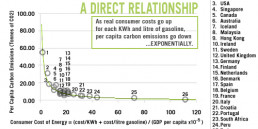
Today in the United States, there is no real incentive for conservation other than the collective moral imperative which undoubtedly falls short. What this exercise is meant to show is that we need to have more creative thinking behind how revenue is generated. Can tax policy be progressive at the same time that it incentivizes energy conservation? What follows is a very simple approach that would be one way of addressing at the same time both income disparity and energy conservation.
The breakdown of fiscal year 2008 tax revenue is as follows:
- Corporate ($300 billion)
- Individual ($1,059 billion)
- Employment ($877 billion)
- Estate/Gift ($28 billion)
- Excise ($49 billion)
- Total (2,300 billion)
The only part of the above breakdown that this study is focused on is the $1,059 billion in individual tax revenues. Everything else would remain unchanged.
STEP 1
The first step in the plan is to take away the income tax entirely for 99% of the population. Currently the cut-off for membership in the top 1% of income earners is approximately $400,000 per year. The average income for that group of privileged 1,683,000 households is one million dollars per year. Currently, they are taxed at 38% of adjusted gross income and I propose that we actually reduce that rate to 30%. How can they argue with that? This will net $510 billion in revenue or about half of what is required to equal the total individual tax revenue amount.
STEP 2
The second step is to implement a tax on excess household energy consumption. The first 80 million btu per year that a household consumes are free of taxation. Currently 28% of households get by on that amount of usage or less. They tend also to be households of lower income. The implementation of a small $0.20 per 1000 btu tax on the usage above 80 million per household will net $330 billion in revenue.
STEP 3
The third step is to apply the incentive at the source of the consumer goods production. The greatest energy consumption comes from the manufacturing sector which consumes twice the amount of btus per year (22.6 quadrillion) as does total residential use (10.6 quadrillion). By dividing the 22.6 quad total consumption by the total square feet of enclosed manufacturing space, you can deduce that the average btu per square foot of manufacturing space is 2.13 million btu per square foot. I propose that the first 2 million btu per square foot be free from taxation and that facilities that require more are taxed at $0.25 for each 1000 btu above 2 million. Of course this added cost of production would be passed right along to the consumer down the chain of production. But this is OK, because if you remember, our consumer population has a lot more dispensable income now that they are not paying income taxes. This part of the plan will net (based on current statistics) $345 billion.
So the total revenue is:
(Step 1) $510 billion + (Step 2) $330 billion + (Step 3) $345 billion = $1,185 billion
(126 billion more than required – which can go to renewable energy investment)
Of course as behavior changes as a result of incentives, the thresholds for energy use would have to go down or the rate taxed per 1000 btu would have to go up. But that would be great because it would mean that the plan is working. Wouldn’t it be great to have to send in copies of your yearly energy bills along with your 1040 every year? The tax forms would remain similar, but there would be new lines to accommodate the energy use figures. And 99% of filers would get to skip the actual income tax portion and go straight to the energy tax portion.
As a case study, let’s assume that you make $55,000 per year and your household consumes 100 million btu per year (add your natural gas which comes in btu already to your electricity which comes in KWh and would have to be converted by multiply x 3,412). At present, you would be paying roughly $10,000 in federal income taxes and you’re already paying $1,600 per year for your household energy needs. The amount you pay for your energy would not change, but when tax day comes around you would have to pay an additional $0.20 for every 1000 btu that you consumed about 80 million (20,000 x $0.20 = $4,000). You would have saved $6,000 that year.
The real bulk of the taxes will be on the largest household energy consumers and those who choose to purchase goods with high embedded energy costs. But they will still not likely see an insurmountable increase except for the most egregious of energy consumers, and it’s really their choice to make…


